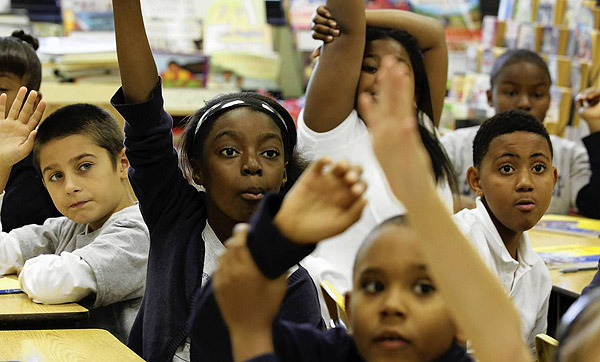One of the things that some folks learned during the strike, as I learned during a trip through the Capitol Fax comments, is the extremely low percentage of white students in Chicago Public Schools. It's not terribly unusual for big-city schools, but nine percent did come as a surprise to many, even people who follow politics and civic issues closely.
Today the New York Times (via Corey Robin) has a piece on a new report about segregation in public schools around the country. Some of it should sound familiar:
Segregation of Latino students is most pronounced in California, New York and Texas. The most segregated cities for blacks include Atlanta, Chicago, Detroit, Houston, Philadelphia and Washington.
“Extreme segregation is becoming more common,” said Gary Orfield, an author of the report who is co-director of the Civil Rights Project.
Going deeper into the report puts "most segregated" in more context. For instance, their data on the percentage of black students in minority schools, broken down by metro area. The highest percentage of black students in 50-100 percent minority schools is Los Angeles, at 94.1; Chicago ranks sixth.
If you narrow that to 90-100 percent, Chicago is number one, at 71.8—meaning that 70 percent of all black students in the Chicago area attend schools that are over 90 percent minority.
Narrowing it further to 99-100 percent, 48.5 percent of black students in Chicagoland—half, essentially—attend schools with basically full minority enrollment. That's a level of extreme segregation ahead of even Detroit-Livonia-Warren, at 47.9 percent. New York-Newark-Edison is third, but at a mere 31.4 percent. Only Los Angeles also tops 30 percent.
Chicago-area schools also top the "dissimilarity" index for black and white students: "a handful of areas experienced extreme school segregation (dissimilarity index score of higher than .70)," a score that indicates 70 percent of that population would have to move in order to achieve even racial distribution. Chicago is at .79 for black-white dissimilarity, the highest, and it's also the highest for black-Asian, black-Latino, and Asian-Latino, and fourth-highest in white-Latino. By geographic segregation, Chicagoland schools are essentially the most segregated in the country.
One of the key points the authors make in the study is that, while public-school enrollment overall has become more diverse, mostly due to Latino immigration (and the baby boom that followed), that hasn't been the case on the school level. 40 years ago white students made up 80 percent of public-school students; they're now a bare majority. And yet:
[L]evels of school segregation are deepening for black and Latino students, according to two segregation indices that rely upon the racial composition of schools. According to these indicators, the average black and Latino student has experienced rising concentration in 50-100% and 90-100% minority schools, declining exposure to white students, and persistent disproportional exposure to poor students.
And this is a fairly rececent trend:
Beyond the logic of changing demography, however, are persistently high—and in many cases worsening—levels of isolation and concentration for black students since the judicial rollback of school desegregation began in the 1990s. These spikes have occurred in spite of declines in black-white residential segregation.
Sociologist Edward Glaeser recently published a widely read report on declining black-white residential segregation, "The End of the Segregated Century." It was also widely criticized, but it did seem to convincingly make the point that, at least on the metropolitan-area level (meaning not just big cities, but smaller cities and suburbs in their orbit), some desegregation has taken place in the past few decades. Yet it hasn't extended to schools. And the authors extend their argument to points that touch on teachers-strike issues:
Teachers are the most powerful influence on academic achievement in schools…. Unfortunately, despite the clear benefits of strong teaching, we also know that highly qualified and experienced teachers are spread very unevenly across schools, and are much less likely to remain in segregated or resegregating settings. High rates of teacher mobility in segregated schools may be related to the fact that teachers in high-poverty, high minority schools are more likely to report problems of student misbehavior, absenteeism, and lack of parental involvement than teachers in other school settings.
Concentrated poverty makes their jobs harder (emphasis mine):
Findings showing that the motivation and engagement of classmates are strongly linked to educational outcomes for poor students date back to the famous 1966 Coleman Report. The central conclusion of that report (as well as numerous follow-up analyses) was that the concentration of poverty in a school influenced student achievement more than the poverty status of an individual student. This is largely related to whether or not high academic achievement, homework completion, regular attendance and college-going are normalized by peers.
And more rote:
The impact of the standards and accountability era has been felt more acutely in minority-segregated schools where rote skills and memorization have, in many instances, subsumed creative, engaging teaching.
It's a sore subject on the policy level because of the political legacy of mandatory desegregation; broader, geographic desegregation policies have essentially been off the table in the U.S. and elsewhere for decades. Preventing de jure segregation is relatively easy; preventing de facto segregation is hard and unpopular. As a result, the authors' recommendations for addressing the problem are modest (city-suburban transfers with federal funding for transportation, magnet schools, transportation funding for increasing charter-school diversity), vague ("there should be funds for building more robust relationships between schools and diverse groups of parents") or both ("creating multiracial coalitions committed to developing whole-school magnets in the gentrifying neighborhood would be a positive way forward"). They contrast the apathy of the current political climate to the civil rights era, but the targets were bigger and badder then. Instead of the elementary atavism of Bull Connor, it's the complex opacity of market forces.




Comments are closed.